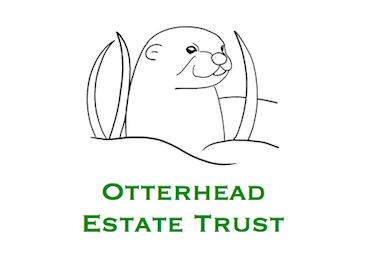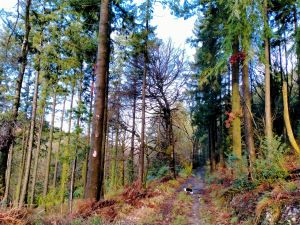Plants & Wildlife

Otterhead Lakes is very rich in wildlife thanks to the many different habitats which are present, including deciduous and coniferous woodland, open sunny grassland glades, lakes, a river and two leats (artificial watercourses).
Woodlands

Around the upper slopes of Otterhead are the conifer plantations where the larch, sitka spruce and Douglas fir create a dark, dense canopy and provide cover for animals such as badgers and roe deer. Hazel trees, some of which are over 250 years old, can be found alongside some of the old hedge banks on the edges of the woodland along with plants such as red campion, lesser stitchwort and bugle.

During February, you will be able to see the lovely carpets of snowdrops in the deciduous woodland of oak, sycamore, ash and birch. This is also where, in the spring, the woodland floor becomes a purple haze of bluebells. Other typical woodland plants are dog’s mercury, enchanter’s nightshade and wood anemone. The broad–leaved helleborine is an orchid which can be found on the woodland edges from July to September.

The bluebell display at Otterhead in the spring is stunning. Bluebells are native to Western Europe and are usually associated with ancient woodland. The UK is a stronghold for this species with 50% of the world population!
Although the flowers are usually a deep violet in colour, occasionally white and pink ones also appear. These early flowering plants are a really important nectar source for insects such as woodland butterflies, hoverflies and bees. Other common names for the bluebell are ‘Cuckoo’s Boots’ and ‘Witches Thimbles’. Bluebells are very senstive to trampling and can easily be killed if their delicate leaves are crushed as they won’t be able to photosynthesise, so please stick to the paths.

For many people, the snowdrops are the highlight of a winter trip to Otterhead. Their Latin name is Galanthus nivalis which translates to ‘milk flower of the snow’. Although snowdrops are considered native plants, they were first cultivated in Britain in 1597 and then spread into the wider landscape with the first record in the wild in 1778. They can survive the cold and flower early as they grow from bulbs, and their leaves have hardened tips to help them break through frozen soil.

The woodlands are alive with birds throughout the year and include greater-spotted woodpeckers, nuthatches, long-tailed tits, blue tits, blackcaps and tawny owls. Long-tailed tits are tiny, sociable and noisy, and they will often be heard in the branches above you before they are seen, as they move around looking for food. In the winter they can form flocks of up to 20 birds and at night they cluster together to stay warm.

Dormice, which are declining in numbers nationally, are still thriving at Otterhead lakes. These elusive mammals are nocturnal and weave nests from honeysuckle bark and leaves. Their round nests are made in holes in trees or within clumps of brambles or tussocky grass, close to the woodland edges.
Six species of bat have been recorded at Otterhead. The trees and the Coach House are used as roosts during the day, and the bats will fly along the woodland rides and glades at night, feeding on moths and other insects.

Around the lake edges lies the boggy wet woodland which is another important habitat at Otterhead. The willow and alder trees here have adapted to grow in wet conditions along with the many mosses, ferns, sedges and rushes. The seeds of the alder cones are enjoyed by birds such as siskins and redpolls.
Grasslands

The open glades at Otterhead come into their own during the summer when there is an abundance of wild flowers such as yarrow, eyebright, devil’s-bit scabious, birds-foot trefoil and black knapweed. These plants in turn attract many species of hoverflies, bees and butterflies. Common carder bumble bees are ginger in colour - they can be found in a wide range of habitats and can often be seen in gardens. There are approximately 250 species of hoverfly in the UK and these are also important pollinators.
The flowers of eyebright are tiny and the plant is semi-parasitic, attaching itself to the roots of other plants, especially grasses, to obtain nutrients. As its name suggests, eyebright has traditionally been used by herbalists to treat eye conditions.

The beautiful peacock butterfly is another common species seen at Otterhead. The bright eyespots have evolved to startle and confuse predators and the undersides of the wings are very dark, making it resemble a dead leaf. Their caterpillars feed on common nettles.

Snakes such as the adder have occasionally been seen basking in the sunny glades, along with common lizards and slow worms. Despite its appearance and its name, the slow worm is actually a legless lizard, and is completely harmless.

Kestrels are a bird of prey belonging to the falcon family and they can often be seen hovering about 10-20m off the ground, using their keen eyesight to spot field voles, one of their main sources of prey. Field voles make a network of tunnels and burrows under the grass but they lay scent trails of urine that reflect ultraviolet light, making them visible to kestrels - who are sensitive to this wavelength of light.
River, lakes and leats
As the name suggests, the Otterhead Estate is almost at the source of the River Otter. The river runs right through the site and connects the two main lakes. These water features provide a wide range of different habitats for plants and animals.

The lakeside vegetation attracts many species of dragonflies and damselflies that lay their eggs on the leaves close to the water. The blue and green emperor dragonfly is one of the largest species in Europe and flies high above the lakes looking for prey, such as butterflies and other smaller dragonflies which it catches and eats on the wing. Common blue and large red damselfly species can also be seen flying here. Frogs and toads are abundant within the still waters of the lakes and other ponds, and the tadpoles of both can be seen in the shallow areas in the spring. These amphibians are in turn a favourite food of grass snakes - which are very good swimmers.

Around the edges of the lakes are bulrushes (reedmace) and other plants such as water starwort, greater tussock sedge and fool’s watercress. The impressive greater tussock sedge can also be seen in some of the boggy areas of woodland and grows in pillars up to 1.5m high and 1m across!

Teal and wigeon can sometimes be seen on the lakes in the winter but mallards, coots, moorhens, mute swans and little grebes can be seen all year round. Special floating islands on the bottom lake have been constructed to provide additional areas of undisturbed vegetation and nesting areas for the birds that live here. The little grebe (also called dabchick) are small and brown with a fluffy bottom. They are diving birds feeding on small fish and invertebrates; when the chicks are young the parents will sometimes carry them on their backs.

The shallow, fast-flowing River Otter linking the upper and lower lakes attracts other forms of wildlife including freshwater shrimps, small brown trout and grey wagtails.
Dippers can also be found here especially near the Cascade, where they characteristically bob up and down while perched on rocks. They feed at the edge of the water but they can also grip the rocks, walk down them and go completely underneath the water looking for stonefly and caddisfly larvae, and mayfly nymphs. These unusual birds also have a third transparent eyelid that they can close and therefore allow them to see underwater.

Plants such as brooklime, opposite-leaved golden saxifrage and marsh marigold are abundant along the edges of the river and ditches. Marsh marigold (also called kingcup) is a member of the buttercup family with heart-shaped leaves and bright yellow flowers that appear in the spring.

Kingfishers can often be seen near the stream and the lakes at Otterhead. These unmistakable brightly-coloured blue and orange birds fly very fast and low over the water and will sit and perch on overhanging branches looking for food. They usually eat small fish such as minnows and sticklebacks but they will also eat aquatic insects, tadpoles and freshwater shrimps. A kingfisher has to eat its own bodyweight of food each day just to survive and they make their nests in burrows that they excavate into stream banks.
For information on the cultivated plants at Otterhead please follow the link below:
Learn more about the Lost Gardens of Otterhead
© Otterhead Estate Trust Ltd 2025